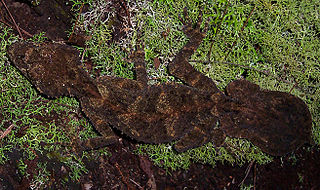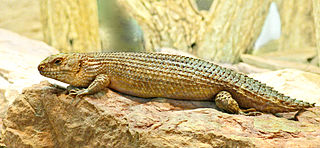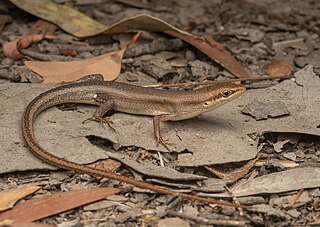
Skinks are lizards belonging to the family Scincidae, a family in the infraorder Scincomorpha. With more than 1,500 described species across 100 different taxonomic genera, the family Scincidae is one of the most diverse families of lizards. Skinks are characterized by their smaller legs in comparison to typical lizards and are found in different habitats except arctic and subarctic regions.

Saltuarius is a genus of larger Australian geckos, known collectively as leaf-tailed geckos.

Carlia is a genus of skinks, commonly known as four-fingered skinks or rainbow skinks, in the subfamily Eugongylinae. Before being placed in this new subfamily, Carlia was recovered in a clade with the genera Niveoscincus, Lampropholis, and others of the Eugongylus group within Lygosominae.

Eulamprus is a genus of lizards, commonly known as water skinks, in the subfamily Sphenomorphinae of the family Scincidae. The genus is native to Australia.

Lampropholis is a genus of skinks, commonly known as sunskinks, in the lizard subfamily Eugongylinae of the family Scincidae. The genus Lampropholis was previously found to belong to a clade with the genera Niveoscincus, Leiolopisma and others of the Eugongylus group within Lygosominae. All species of Lampropholis are endemic to Australia. For similar skinks see genera Bassiana, Pseudemoia, and Niveoscincus.
Nangura spinosa, the Nangur spiny skink or Nangur skink, is a lizard known from two patches of dry-rainforest in South East Queensland, Australia. It was formerly placed in the monotypic genus Nangura but was moved to Concinnia following the molecular phylogenetic studies of O'Connor & Moritz (2003) and Skinner and co-authors (2013). It was returned to Nangura in 2018. This species is known only from two localities; the type locality, now in Nangura National Park, and a much smaller isolated population in Oakview National Park and adjacent Oakview State Forest. The total distribution spans just 42 square kilometers, within which this species occupies less than 4 square kilometers, with an estimated population size of less than 200 individuals. It is threatened by invasive species including cats, pigs, dogs, foxes and cane toads, by the invasive plant species Lantana camara, which increases fire risk and changes forest structure, and in some sites by logging and road maintenance. Consequently, it is listed as critically endangered under the Australian Environment Protection and Biodiversity Conservation Act 1999 It resembles Gnypetoscincus queenslandiae in its spiny scales and like that species it is live bearing. Along with minor differences in scalation, the Nangur spiny skink differs from other Australian Sphenomorphid skinks in its karyotype of 2n=28 chromosomes, where most others have 2n=30. It is also unlike related species in that it lives in burrows, which occur in small colonies through the dry rainforest habitat. There is some indication of parental care in this species, with adults sharing burrows with juveniles.

Saproscincus is a genus of skinks native to Australia, sometimes referred to as shadeskinks. It contains the following species:

Plestiodon is a genus of lizards in the family Scincidae (skinks). The genus contains many species formerly classified under the genus Eumeces, except those now placed in Mesoscincus. They are secretive, agile animals with a cylindrical body covered with smooth, shiny scales. They are distributed from East Asia to throughout North America from southern Canada south to Mexico, including oceanic islands such as Bermuda.
The Satinay sand skink, also known commonly as the Fraser Island sand skink, is a species of lizard in the family Scincidae. The species is native to Australia.
Techmarscincus is a genus of skink, a lizard in the family Scincidae. The genus is endemic to Australia, and is monotypic, containing the sole species Techmarscincus jigurru.
The Quinkan ctenotus is a species of Australian skink, a lizard in the family Scincidae.
Pygmaeascincus is a genus of skinks, lizards in the family Scincidae. All member species are endemic to Australia.

Egernia stokesii is a gregarious species of lizard of the Scincidae family. This diurnal species is endemic to Australia, and is also known as the Gidgee skink, spiny-tailed skink, Stokes's skink and Stokes's egernia. The species forms stable, long-term social aggregations, much like the social groups seen in mammalian and avian species. This characteristic is rarely found in the Squamata order, but is widespread within the Australian subfamily of Egerniinae skinks. Populations of E. stokesii are widely distributed, but fragmented, and occur in semi-arid environments. There are three recognised subspecies. The conservation status for the species is listed as least concern, however, one subspecies is listed as endangered.
Lyon's snake-eyed skink is a species of lizard in the family Scincidae. The species is endemic to Queensland in Australia.

Carlia jarnoldae, also known commonly as the lined rainbow-skink or the lined rainbow skink, is a species of lizard in the subfamily Eugongylinae of the family Scincidae. The species is endemic to the state of Queensland in Australia.

Carlia storri, also known commonly as the brown bicarinate rainbow-skink or Storr's carlia, is a species of lizard in the family Scincidae. The species was first described by Glen Joseph Ingram and Jeanette Covacevich in 1989. It is native to Papua New Guinea and the Australian state of Queensland.
Cryptoblepharus fuhni, also known commonly as the black-boulder shinning-skink, is a species of lizard in the family Scincidae. The species is endemic to Queensland in Australia.
Lygisaurus tanneri, also known commonly as the Endeavour River litter-skink and Tanner's four-fingered skink, is a species of lizard in the family Scincidae. The species is endemic to Australia.
The nubbinned fine-lined slider is a species of skink, a lizard in the family Scincidae. The species is endemic to Queensland in Australia.
Lerista ingrami, also known commonly as the McIvor River slider, is a species of skink, a lizard in the family Scincidae. The species is endemic to Queensland in Australia.









